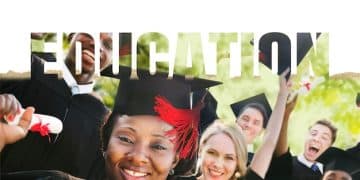Navigating Student Loan Forgiveness Programs: Your 2025 Guide

Navigating student loan forgiveness programs can be complex. This comprehensive guide for 2025 breaks down eligibility requirements, application processes, and key changes to help you understand and potentially benefit from available programs.
Millions of Americans struggle with student loan debt, and understanding your options for relief is crucial. This guide, **navigating student loan forgiveness programs: a comprehensive guide for 2025**, is designed to provide you with the knowledge and resources needed to explore potential pathways to debt forgiveness.
Understanding Student Loan Forgiveness Programs
Student loan forgiveness programs offer a lifeline to borrowers burdened by overwhelming debt. These programs, often government-sponsored, provide opportunities to have a portion or all of your outstanding student loan balance canceled after meeting specific requirements.
Navigating the landscape of available programs can be daunting, but understanding the basic principles is the first step towards potential financial relief.
Federal vs. State Forgiveness Programs
Federal student loan forgiveness programs are offered by the U.S. Department of Education and are generally available to borrowers nationwide. State-level programs, on the other hand, may have specific eligibility criteria based on residency or profession.
Key Differences in Program Requirements
Each forgiveness program has its own unique set of requirements. These may include factors such as employment type, income level, and loan type. Carefully reviewing the eligibility criteria for each program is essential before applying.
- Public Service Loan Forgiveness (PSLF) for those in public service jobs.
- Income-Driven Repayment (IDR) forgiveness for those with qualifying income.
- Teacher Loan Forgiveness for qualifying educators.
Understanding these differences is crucial for determining which program, if any, aligns with your individual circumstances. Eligibility hinges on several factors that must be carefully evaluated.

Exploring Federal Student Loan Forgiveness Options
The U.S. Department of Education offers several federal student loan forgiveness programs designed to assist borrowers in various situations. These programs represent a significant opportunity for eligible individuals to alleviate their student loan debt.
Let’s delve into some of the most prominent federal programs and their respective eligibility criteria.
Public Service Loan Forgiveness (PSLF)
The PSLF program is designed for individuals employed by qualifying public service organizations. To be eligible, borrowers must make 120 qualifying monthly payments under a qualifying repayment plan while working full-time for a qualifying employer.
Income-Driven Repayment (IDR) Forgiveness
IDR plans, such as Income-Based Repayment (IBR), Pay As You Earn (PAYE), and Revised Pay As You Earn (REPAYE), offer forgiveness after a specified period of qualifying payments. The forgiveness period typically ranges from 20 to 25 years, depending on the plan.
- IBR: Repayments are capped at 10-15% of discretionary income.
- PAYE: Repayments are capped at 10% of discretionary income.
- REPAYE: Repayments are typically capped at 10% of discretionary income.
Navigating these programs requires careful attention to detail, especially concerning qualifying payments and employer verification.
State-Specific Student Loan Forgiveness Programs
Many states offer their own student loan forgiveness programs to attract and retain professionals in high-need fields. These programs often target specific occupations, such as teachers, nurses, and doctors, and provide financial incentives to work in underserved areas.
Exploring state-specific programs can uncover additional opportunities for debt relief, but eligibility is typically tied to residency or employment within the state.
Forgiveness for Teachers
Several states offer student loan forgiveness programs specifically for teachers who work in designated shortage areas or schools serving low-income populations. These programs aim to incentivize educators to serve in communities where they are most needed.
Forgiveness for Healthcare Professionals
Healthcare professionals, such as nurses, doctors, and dentists, may be eligible for student loan forgiveness programs in states with healthcare shortages. These programs often require a commitment to work in a designated underserved area for a specified period.
- Nurse Corps Loan Repayment Program.
- State Loan Repayment Program (SLRP).
- National Health Service Corps (NHSC) Loan Repayment Program.
These programs are vital for addressing critical workforce shortages and improving access to essential services in underserved communities. Eligibility requirements can vary significantly from state to state.

Understanding Eligibility Requirements for 2025
Eligibility for student loan forgiveness programs is determined by a variety of factors, including loan type, employment, income, and repayment plan. Meeting all the eligibility requirements is essential to successfully qualify for forgiveness.
Carefully reviewing the specific criteria for each program is crucial before submitting an application. Changes to eligibility criteria can occur, so staying informed is key.
Loan Type
The type of student loan you have (e.g., federal Direct Loans, Federal Family Education Loan (FFEL) Program loans, Perkins Loans) can impact your eligibility for certain forgiveness programs. Some programs may only be available for specific loan types.
Employment
Many forgiveness programs, such as PSLF and teacher loan forgiveness, require employment in a qualifying public service or designated profession. The definition of “qualifying employment” can vary, so it’s essential to understand the specific requirements of the program.
- Full-time employment requirements for PSLF.
- Qualifying employers: government organizations, non-profits.
- Verification of employment through employer certification.
Understanding these requirements is essential for ensuring you meet the necessary conditions to qualify for student loan forgiveness. Borrowers should meticulously track their employment history and loan payments.
The Application Process: A Step-by-Step Guide
Applying for student loan forgiveness programs involves a multi-step process that requires attention to detail and thorough documentation. Knowing each stage of the application process will increase the chances of having the application approved.
Here’s a step-by-step guide to help you navigate the application process effectively.
Gathering Required Documents
Before starting the application, gather all the necessary documents, such as proof of income, employment verification, and loan statements. Having these documents readily available will streamline the application process.
Completing the Application Form
Carefully complete the application form, providing accurate and up-to-date information. Double-check all entries to avoid errors or omissions that could delay or disqualify your application.
- Submitting the PSLF Employment Certification Form (ECF).
- Applying for Income-Driven Repayment (IDR) plans.
- Understanding annual income recertification requirements.
Staying organized, meeting deadlines, and providing accurate information are critical for a successful application. Consult the program’s official website for the most current forms and instructions.
Potential Changes to Forgiveness Programs in 2025
Student loan forgiveness programs are subject to political and economic factors, and changes to their eligibility requirements, funding, or administration can occur. Staying informed about potential changes is crucial for borrowers planning to apply for forgiveness in 2025.
Monitoring legislative updates, agency announcements, and expert analyses can provide insights into potential program modifications. Here is what you should monitor:
Legislative Updates
Keep an eye on legislative proposals and enacted laws that could impact student loan forgiveness programs. New legislation could expand eligibility criteria, increase funding, or introduce new programs.
Agency Announcements
The U.S. Department of Education and other relevant agencies regularly issue announcements and guidance regarding student loan forgiveness programs. Stay informed by subscribing to agency newsletters and monitoring their websites.
- Tracking updates from the Department of Education.
- Following news on student loan policy changes.
- Consulting with financial advisors and experts.
Staying proactive in monitoring these potential changes can help you make informed decisions about your student loan repayment strategy. Flexibility and adaptability are key in navigating this evolving landscape.
| Key Point | Brief Description |
|---|---|
| ✅ PSLF | Forgiveness for public service employees after 120 qualifying payments. |
| 💰 IDR Plans | Forgiveness after 20-25 years under income-driven repayment plans. |
| 👩🏫 Teacher Forgiveness | Forgiveness for teachers in low-income schools after 5 years. |
| ⚕️ State Programs | Additional options for specific professions, like healthcare. |
Frequently Asked Questions
▼
PSLF forgives the remaining balance on your Direct Loans after you’ve made 120 qualifying monthly payments while working full-time for a qualifying employer. These employers are typically government organizations or non-profit entities.
▼
IDR plans base your monthly loan payments on your income and family size. After a set number of years (typically 20-25), the remaining balance is forgiven. You need to recertify your income each year.
▼
Yes, many states offer loan forgiveness programs, often targeting professions with shortages like teaching or healthcare. Eligibility requirements can vary, so check your state’s Department of Education website.
▼
Generally, federal Direct Loans are eligible for forgiveness programs. Other federal loans, like FFEL or Perkins Loans, might need to be consolidated into a Direct Loan. Private loans are generally not eligible.
▼
Visit the U.S. Department of Education’s website (studentaid.gov) for comprehensive information on federal loan programs and application processes. Your loan servicer can also provide personalized guidance and support.
Conclusion
Successfully **navigating student loan forgiveness programs: a comprehensive guide for 2025** requires diligent research, careful planning, and proactive monitoring of program updates. By understanding your options, meeting eligibility requirements, and staying informed, you can increase your chances of securing financial relief and achieving long-term financial well-being.





